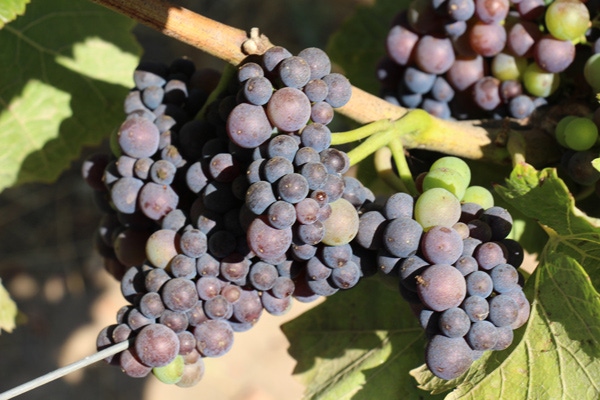
“Pruning, shoot thinning, leaf pulling, fertilization, irrigation and other cultural practices, of course, are important. But, I’m a firm believer in terroir and the role soil plays in that. Producing a crop has a negative impact on the soil in terms of the amount of nutrients removed from the soil and damage to soil structure from equipment traffic. My goal in growing grapes is to keep the soil healthy and happy.”

Judging by the size of the clusters he was seeing in early June, Sacramento County grower Joe Salman is projecting his family’s Delta wine grape crop will be no larger, and maybe even a bit smaller, than last year. That crop came in about 15 percent smaller than the large 2014 crop.
“The only fields that seem to be doing better than last year are the two younger ones,” he says.
His family, which began farming this ground in the 1920s, has been growing grapes in the Clarksburg AVA, since 1969. That’s when Joe’s father, Enver, planted Salman Farms’ first vines, French Colombard and Petite Sirah among others.
Today, the family’s 450 acres of vineyards near Courtland, Calif., include more than a dozen varieties, ranging from Chardonnay, Chenin Blanc and Fiano to Cabernet Franc, Cabernet Sauvignon, and Petit Verdot.
This year’s bloom was a little sporadic. It began with the Chardonnay on April 18 and concluded the first week of May when the Cabernet Franc and Cabernet Sauvignon finished blooming. That’s similar to the timing of last year’s bloom.
Except for some older, flood-irrigated sections, the rest of the vineyards are equipped with drip irrigation systems. All are irrigated with surface water. Like other water rights holders in this area, Salman Farms was on a voluntary water restriction last year. This year, other than state-required monitoring and reporting of water use, there are no water restrictions for his fields.
Good soil moisture levels, following wet winter and spring weather, allowed him to delay irrigating his vines until the first week of June. Starting with his driest areas, he plans to be irrigating all his fields by the end of June.
So far, powdery mildew pressure this year has been a little higher than usual. Joe Salman began treating his vines for this fungal disease at the first appearance of green tissue. He dusts the vines every seven to 10 days and applies the fungicides every 14 to 21 days. It works out to about three dust applications and one fungicide treatment during one month. He’ll continue this program until about three weeks before veraison, when he makes his last fungicide application.
For the most part, pest pressure has been light. However, in early May, leafhoppers showed up in unusually high numbers. “They came early,” Salman says. “They were in a younger, vigorously growing vineyard. I don’t know why. That’s something different for us.” He uses insecticide sprays as needed to control them.
As Salman sees it, success in producing a high-quality grape crop hinges on the quality of the soil. “Pruning, shoot thinning, leaf pulling, fertilization, irrigation and other cultural practices, of course, are important,” he says. “But, I’m a firm believer in terroir and the role soil plays in that. Producing a crop has a negative impact on the soil in terms of the amount of nutrients removed from the soil and damage to soil structure from equipment traffic. My goal in growing grapes is to keep the soil healthy and happy.”
His soil-nurturing practices include the use of cover crops to enhance soil structure and amendments such as organic acids and compost teas to provide an environment that allows soil microorganisms to thrive and function properly for optimum soil productivity.
About 10 years ago, the Salmans, who have long sold their grapes to wineries in Napa and Sonoma Counties, the Sierra Foothills and locally, began developing their own winery, Grand Island Vineyards. It features a tasting room, facilities for wedding and other events and landscaped grounds.
“It’s been a good move for us,” says Salman, who also manages the winery operations. “Although not the most well-known wine-producing area of California, our Clarksburg area produces quality grapes that are used to make high quality wines. It’s nice to be on both sides of the wine market and have another source of revenue.”
The wines are bottled under the Bridgehead label. Currently, the best-selling white wine is their Fiano, a white variety his father came across during a trip to Italy.
“It’s a very complex, medium-bodied wine with a honeysuckle nose and a hazelnut flavor,” Joe says. “I’m a little surprised that it’s as popular as it is. Cabernet Franc is our overall best seller.”
About the Author(s)
You May Also Like



